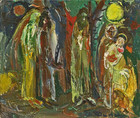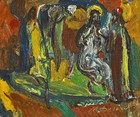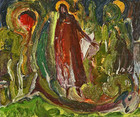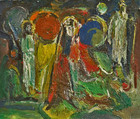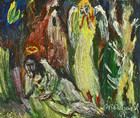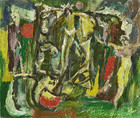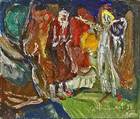Ivan Filichev
Russian Artist Ivan Filichev was born in 1937, during the Great Purge, when Dictator Joseph Stalin launched a brutal campaign of political repression, murder, and mass arrests across the U.S.S.R. He has memories of World War II bombing raids in 1941, when Nazi soldiers invaded his home region of Bryansk in Southwest Russia. His older brother was a teen-aged partisan, who helped liberate the city in 1943 and died at the front. Studying Filichev’s biography, you will find most of his life and artistic career were inextricably intertwined with the history of the Soviet Union. He now lives in the post-Communist world of art making, where old boundary lines are gone, most themes are permissable, and market forces work much as they do in the West
Filichev's first formal art training in the 1950s was in the officially-sanctioned style of Socialist Realism. While studying at the Fine Arts-Industrial Institute in the Ukrainian city of Kharkov, he was sent out to paint coal miners in the Kuzbass region of Southwest Siberia, where he eventually settled in the city of Kemerovo in 1963. He made portraits of Soviet border guards involved in the 1969 Sino-Soviet border dispute and depicted workers at the Baikal-Amur railway construction site in the 1970s. Filichev was named an Honored Artist of the Russian Republic and participated in exhibitions at the local, regional, and national level from 1961 onwards. He did not count amount the dissident artists who found admirers in the West.
Filichev seems an unlikely entry in my list of modern sacred art makers. After all, religion was considered to be “the opium of the people” in the world’s first Communist state and religious themes were frowned upon, if not censored, by official cultural commissars. In reality, every church in the Soviet Union would have to have been torn down to prevent some vestige of the sacred from appearing in the visual arts of the Soviet era. As a student, Filichev painted the cupola-domed churches of Yelets, the city where he first studied art, and, later, the Trinity Monastery of St. Sergius, outside of Moscow. Sacred architecture still features prominently in his landscapes. Like many Russian artists and intellectuals of his generation, he was baptized into the Eastern Orthodox faith, thanks to a faithful grandmother who took him to church as a child.
Filachev’s major works on religious themes date from after 1988, when Communist Party Leader Mikhail Gorbachev held a historic meeting with Russian Orthodox Church leaders in the Kremlin, inaugurating a new era of religious tolerance and spiritual renewal in Russia. Filichev’s sacred art owes much to the iconography of Theophanes the Greek and Andrei Rublev, as well as to the Baroque paintings of El Greco, but he does not feel obliged to follow traditional biblical imagery and subjects. The Russian artist says his true spiritual mentor is French Post Impressionist Paul Cezanne, whom he considers “one of the demigods of art.”
As can be seen in the seven oil on cardboard paintings in the Sacred Art Pilgrim Collection, Filichev’s works have geometrically modeled compositions and complex color contrasts, recalling the work of Cezanne. The artist applies thick layers of paint, working in an abstract figurative style. Angels and haloed figures often suggest a sense of the sacred. Some paintings, like Crucifixion and Holy Birth, draw on the traditional visual conventions of religious art. Other pieces need to be identified with titles. Don't ask Filichev for any more details. “You need to look at the work” he says. “If you have to ask about it, you’re not going to understand it.”
Filichev describes himself as “a believer but not a fanatic.” He does see the hand of God at work in whatever he paints, whether it be a Madonna or a coal-miner. “I might work on a landscape or a religious theme.” says Filichev. “It starts with a certain feeling, an inner pull, a desire to make something. If it gets painted, then, God has allowed it. Everything must be done in a professional way. Some people pray, cross themselves, fast, and when they paint, the result is trash.”
